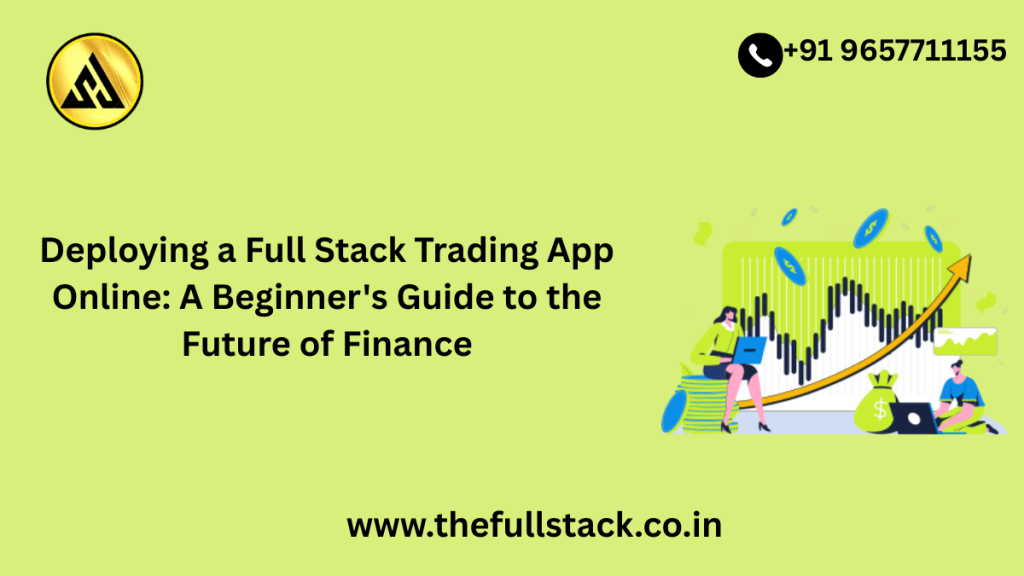In today’s fast-paced digital world, financial literacy and tech-savviness go hand in hand. One of the most exciting and empowering ways to explore both is by building and deploying a full stack trading app online. Whether you’re a curious individual looking to better understand the markets or an employee in the fintech space hoping to upskill, this guide is your gateway into the future of trading technology.
What Is a Full Stack Trading App?
A full stack trading app is a web application that combines frontend (user interface), backend (server-side logic), and database management to allow users to trade stocks, cryptocurrencies, or other assets in real time. Imagine the power of Robinhood, Coinbase, or Zerodha—all simplified for your own customized use.
This app typically includes:
- Frontend: What users interact with (React.js, Vue.js, etc.)
- Backend: Where all the data processing happens (Node.js, Python, etc.)
- Database: Where trades, user profiles, and historical data are stored (MongoDB, PostgreSQL)
- APIs: Connections to real-world financial data (like Alpaca, Yahoo Finance, or Binance)
Why Build and Deploy One?
💡 Real-World Relevance
By deploying a trading app, you gain a hands-on understanding of how financial markets work, how data is visualized, and how trades are executed in real time. This is a valuable experience not only for developers but also for finance professionals, business analysts, and product managers.
📈 Stay Ahead of Industry Trends
The financial technology (fintech) industry is booming. From algorithmic trading to decentralized finance (DeFi), there’s a massive demand for talent that understands both finance and technology. Building your own app is one of the best ways to stay ahead of the curve and demonstrate initiative.
🌍 Make an Impact
A well-deployed trading app can go beyond personal use—it can become a learning platform, a tool for investment clubs, or even a startup MVP. It’s not just about learning; it’s about creating.
Step-by-Step: How to Deploy Your First Trading App
Here’s a simplified path for beginners:
1. Start with a Basic App
Focus on the fundamentals:
- User login/signup
- Dashboard to show current prices
- Option to place mock buy/sell trades
- Portfolio tracker
💡 Tip: Use free APIs like Alpaca or Yahoo Finance to fetch real-time data.
2. Choose Your Tech Stack
Here’s a common beginner-friendly stack:
- Frontend: React.js
- Backend: Node.js + Express
- Database: MongoDB (NoSQL) or PostgreSQL (SQL)
- Hosting: Vercel for frontend, Render or Heroku for backend
📌 Example: Create the frontend with React, use Express for backend APIs, and host the app using Vercel or Netlify.
3. Connect to a Financial API
Trading apps need data. Use:
- Alpha Vantage
- Alpaca (Paper Trading)
- CoinGecko (for crypto)
Make sure you understand how to fetch, parse, and display this data securely.
4. Deploy Your App
Once everything is built and tested locally:
- Push your frontend to GitHub
- Connect it to Vercel or Netlify
- Deploy your backend on Render or Heroku
- Link your domain and ensure SSL is active
👨💻 Don’t forget environment variables! Never expose API keys in the frontend.
Real-World Applications
Building and deploying your trading app has many real-life applications:
- Education: Teach students or colleagues how markets work.
- Prototyping: Create MVPs for startup ideas.
- Portfolio Projects: Perfect for job seekers in fintech, data science, or software development.
- Automation: Add bots or signals for advanced features like auto trading.
Industry Insights: Where is Trading Tech Heading?
The world is shifting towards decentralized finance, AI-powered trading bots, and API-first platforms. Companies like Robinhood, Binance, and Zerodha are changing the game—and there’s room for innovation.
According to Statista, the global fintech market is projected to reach $699 billion by 2030. Learning how to deploy trading platforms today positions you to be part of that growth.
Motivational Tip: You Don’t Need to Be an Expert
It’s easy to feel overwhelmed when hearing terms like APIs, deployment pipelines, or stock tickers. But remember this: every expert once started as a beginner.
You don’t need a finance degree or coding bootcamp. Just a bit of curiosity, some free time, and a willingness to experiment.
Start small. Make it fun. Share your app with friends. Iterate. Improve. Grow.
Final Thoughts: The First Step to Financial and Technical Freedom
Deploying your own trading app is more than just a cool tech project. It’s a step toward:
- Understanding financial markets
- Learning full stack development
- Creating real-world solutions
- Improving your career prospects
Whether you’re a student, a tech professional, or just someone curious about how investing works—this is your invitation to dive in.
📚 Ready to Level Up?
Explore our advanced courses, templates, and workshops on full stack development and trading systems. Let’s turn your curiosity into expertise.
👉 Visit our Learning Hub to get started today.
You might be like this:-
What is AWS Lambda?A Beginner’s Guide to Serverless Computing in 2025
Java vs. Kotlin: Which One Should You Learn for Backend Development?

